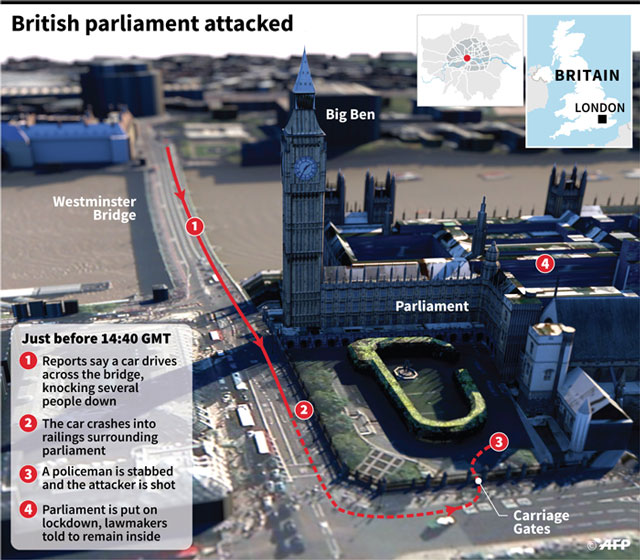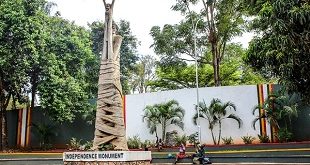
London, United Kingdom | AFP | Three people were killed in an “Islamist-related” attack in the heart of London on Wednesday when a man mowed down pedestrians on a bridge, then stabbed a police officer outside parliament before being shot dead.
Here is what we know about the deadliest attack in Britain since 2005.
– What happened? –
At around 2:40 pm (1440 GMT), the attacker rammed a car along the pavement on Westminster Bridge, a busy traffic route that is also a popular tourist spot with its views of parliament and its Big Ben clock tower.
After ploughing into several people on the bridge, the attacker crashed the car into the railings outside parliament and then tried to enter the building, stabbing a policeman with a large knife. Armed officers shot the attacker dead.
In total the assailant killed three people during the rampage: two members of the public and the stabbed police officer. Authorities revised down the toll after earlier saying the attacker had killed four people.
Some 30 people were wounded, including five South Korean tourists, two Romanians, a Portuguese man and three French schoolchildren.
Five people were left in critical condition and two others had “life-threatening” injuries.
Britain’s top counter-terror officer Mark Rowley said that eight people arrested in locations including London and second city Birmingham were being investigated “on suspicion of preparation of terrorist acts.”
– How did authorities respond? –
Parliament was swiftly put on lockdown during the attack and lawmakers and staff confined to the building for several hours.
Police cordoned off a large area around the parliament in Westminster, shutting the bridge and nearest Underground station, as emergency vehicles swarmed the area.
Prime Minister Theresa May, who was in parliament at the time of the attack, was rushed out of the building by car.
After chairing a meeting of the government’s COBRA emergencies committee, she described the attack as “sick and depraved” and confirmed that Britain would maintain its terror threat level at “severe”.
A police spokesman said extra officers would be put on patrol in London and urged the public to be vigilant.
Parliament reopened early Thursday, in a show of defiance. May vowed that the country would not be cowed, saying: “We are not afraid.”
– What is known about the attacker? –
Police named the attacked as 52-year-old Khalid Masood, also known by a number of aliases.
Born on Christmas Day 1964 in Kent in southeast England, Masood had been living in the West Midlands and had a string of convictions for various offences but none of them terror-related.
May said the suspected attacker, reportedly a married father-of-three, was British born and had been investigated by the MI5 domestic intelligence agency “in relation to concerns about violent extremism.”
However, he was “not part of the current intelligence picture,” May told MPs.
Press Association news agency photos, believed to be of the attacker lying on an ambulance stretcher, showed a burly, bearded man wearing black clothes.
According to the BBC, he told the car rental company that he was a teacher.
“He was a nice guy. I used to see him outside doing his garden,” Iwona Romek, a former neighbour of his told the Birmingham Mail.
– Has anything like this happened in London before? –
London’s transport system was hit by four co-ordinated suicide bomb attacks in July 2005 that left 52 people dead, carried out by British attackers inspired by the Al-Qaeda terror network. There was an attempted second wave of attacks two weeks later.
In 2013, two Islamic extremists killed soldier Lee Rigby on a London street by hitting him with a car before attempting to behead him.
Last August, a paranoid schizophrenic knifeman who tried to behead a commuter in a London Underground station in an Islamic State-inspired attack was sentenced to life behind bars.
In terms of attacks on parliament, Airey Neave — the shadow Northern Ireland Secretary and a close friend of Conservative Party leader Margaret Thatcher — was killed by an Irish National Liberation Army car bomb in the House of Commons car park.
Shortly before Britain voted to leave the European Union last year, a Nazi-inspired man shot and stabbed to death Jo Cox, a 41-year-old MP.
The latest incident comes with Europe on high alert after a series of deadly jihadist attacks, including the Brussels bombings exactly a year ago on March 22, 2016.
 The Independent Uganda: You get the Truth we Pay the Price
The Independent Uganda: You get the Truth we Pay the Price




